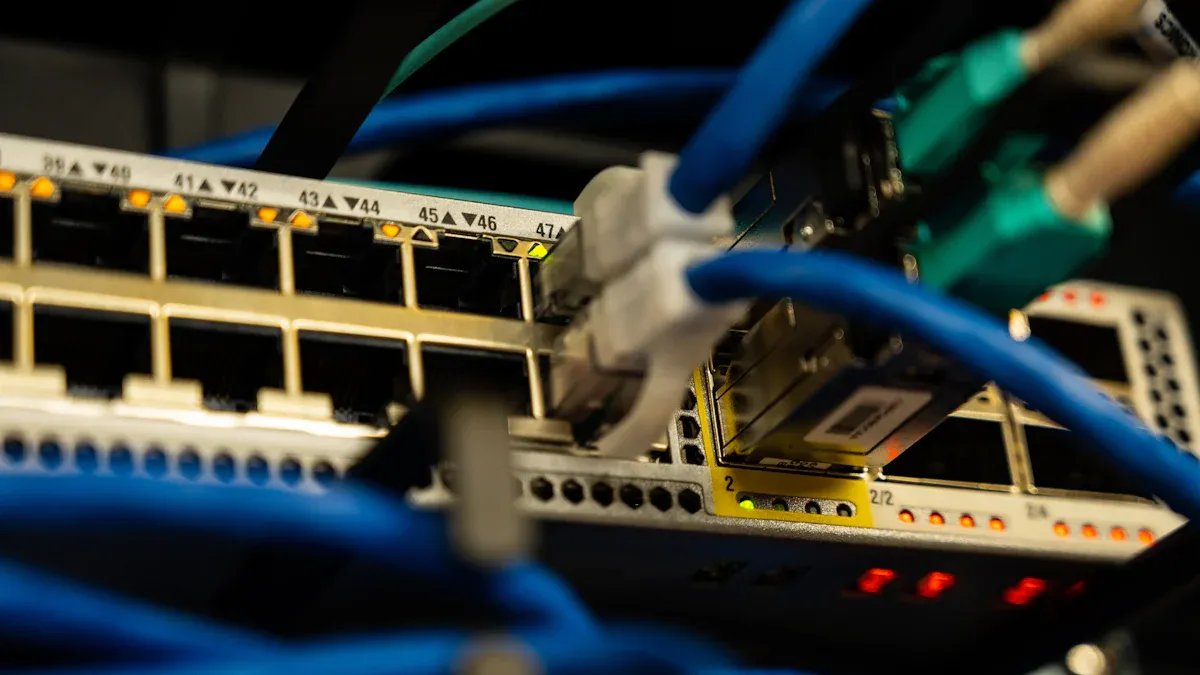
The Public Switched Telephone Network (PSTN) serves as the backbone of global voice communication. For decades, it has connected individuals through a network of central exchanges, copper wires, and fiber optics. Its circuit-switched system ensures stable, high-quality calls. PSTN remains vital today, especially in areas where internet-based systems like IP Public Telephone face limitations. Additionally, the availability of station public telephone services ensures that people can make calls even in remote locations. In correctional facilities, the jail wall mounted telephone provides inmates with a means to communicate with the outside world. Furthermore, handsfree public telephone options enhance accessibility for users, making it easier for everyone to stay connected.
How the Public Switched Telephone Network Works

Key Components of the Station Public Telephone System
The Public Switched Telephone Network relies on several critical components to function effectively. Local exchanges connect subscribers within a specific area, routing their calls to the appropriate destination. Switching centers act as intermediaries, linking different local exchanges to ensure seamless communication. Telephone lines, often made of copper or fiber optic cables, serve as the physical medium for transmitting voice data. Fiber optic cables, in particular, offer high-speed capabilities, enhancing call quality. Cellular networks integrate mobile phone services into the PSTN, while satellites provide connectivity in remote or underserved regions. These components work together to ensure the station public telephone system remains reliable and accessible.
How Calls Are Routed Through PSTN
The process of routing calls through the PSTN involves several steps. When a caller dials a number, their telephone sends a signal to the local exchange. The exchange interprets the number to determine the destination. For local calls, a direct path is established between the caller and the recipient. Long-distance calls, however, are routed through multiple exchanges using trunk lines. Centralized switches act as nodes, facilitating communication between different network sites. Signaling systems, such as Signaling System No. 7 (SS7), manage the setup, maintenance, and termination of calls. This system also supports advanced features like call forwarding and caller ID, enhancing the overall user experience.
Circuit Switching and Call Quality
The PSTN uses circuit switching to establish a dedicated communication path between two parties during a call. This method ensures consistent call quality by reserving the necessary bandwidth for the duration of the conversation. Unlike packet-switched networks, which divide data into smaller packets, circuit switching maintains a continuous connection, reducing latency and packet loss. Built-in self-test and recovery mechanisms further enhance the network’s dependability. Operators monitor telephone switches around the clock and can modify switch software remotely to address issues. Automated systems also select alternative routes for call traffic if the preferred route becomes unavailable, ensuring uninterrupted service.
Costs, Benefits, and Drawbacks of PSTN
Costs for Consumers and Businesses
The Public Switched Telephone Network imposes varying costs on consumers and businesses. Residential users typically pay between $20 and $50 per month for basic services, while businesses incur monthly charges ranging from $50 to $100. Installation fees also differ, with residential setups costing $50 to $200 and business installations ranging from $100 to $500. International calls add further expenses, with rates varying from $0.10 to $1.00 per minute.
Additional costs arise from features like call waiting, caller ID, and voicemail. Businesses often require advanced functionalities such as call forwarding and conference calling, which increase expenses. Scaling the network for growing organizations can be costly due to the need for additional hardware and wiring. These factors make PSTN a significant investment for both individuals and enterprises.
Benefits of PSTN
Despite its costs, PSTN offers several advantages that have sustained its relevance. Reliability remains one of its strongest attributes. The circuit-switched technology ensures consistent call quality, even during peak usage periods. Its global reach allows users to connect with anyone worldwide, making it indispensable for international communication.
The station public telephone system enhances accessibility, especially in remote areas where internet-based alternatives may be unavailable. PSTN also integrates seamlessly with cellular networks and satellite systems, ensuring connectivity in underserved regions. These benefits make it a dependable choice for users who prioritize stability and reach.
Drawbacks of PSTN
PSTN faces several challenges that limit its scalability and efficiency. High costs associated with equipment purchases, installation fees, and monthly line rentals burden users. Maintenance and upgrades are expensive due to aging infrastructure, and declining landline usage makes it harder to justify these expenses.
Scaling the network for growing businesses is complex and disruptive. Adding new lines requires additional hardware and wiring, which increases costs and delays implementation. PSTN’s reliance on circuit-switched technology also limits its ability to handle large volumes of data traffic, making it less suitable for modern digital communication needs. These drawbacks highlight why many organizations are transitioning to alternative systems.
Modern Alternatives to PSTN

Overview of VoIP and Other Technologies
Modern communication technologies have introduced alternatives to the Public Switched Telephone Network, offering enhanced flexibility and cost efficiency. Voice over Internet Protocol (VoIP) has emerged as a leading option, enabling voice and video calls over the internet. It supports advanced features like multi-party conferencing and integrates seamlessly with cloud-based infrastructures.
Other technologies also challenge PSTN’s dominance:
- Mobile Networks (4G and 5G): These provide high-speed wireless communication and support services beyond voice calls, such as video streaming and data sharing.
- Unified Communication Platforms: These integrate voice, video, and messaging, ensuring seamless connectivity across devices.
- Satellite Communication: This technology ensures reliable voice and data services in remote or underserved areas, where traditional PSTN infrastructure may not reach.
The VoIP market has grown significantly, with a projected expansion of USD 21.59 billion from 2024 to 2028. This growth is driven by cost efficiency and advancements in AI-powered technologies.
Comparing PSTN and VoIP
PSTN and VoIP differ significantly in terms of technology, cost, and scalability. The table below highlights these differences:
| Feature | PSTN | VoIP |
|---|---|---|
| Technology | Circuit-switched system | Packet-switched internet-based system |
| Cost | Higher due to infrastructure needs | Lower, leveraging existing internet |
| Flexibility | Limited to landlines | Supports multiple devices |
| Features | Basic calling features | Advanced features like conferencing and voicemail |
| Scalability | Difficult and costly | Easy and cost-effective |
VoIP’s ability to leverage existing internet connections makes it a more economical choice for businesses and consumers. Its advanced features and scalability further enhance its appeal.
Why Businesses Are Moving Away from PSTN
Businesses are increasingly transitioning from PSTN to modern alternatives like VoIP. The high costs associated with PSTN infrastructure and maintenance make it less viable in today’s competitive environment. VoIP offers lower operational costs, advanced features, and seamless scalability, making it an attractive option for organizations of all sizes.
Additionally, VoIP’s integration with unified communication platforms allows businesses to streamline operations and improve collaboration. Satellite communication and mobile networks also provide reliable connectivity in areas where PSTN may be unavailable. These factors highlight why businesses are moving away from traditional systems like the station public telephone and embracing modern technologies.
The Public Switched Telephone Network (PSTN) remains a cornerstone of global communication, offering reliability and extensive reach. However, its high maintenance costs, limited scalability, and declining landline usage have reduced its appeal.
- Key trends shaping PSTN’s future:
- Transition to IP-based networks.
- Integration with 5G for enhanced connectivity.
- Adoption of IoT and AI technologies.
Modern alternatives like VoIP and unified communication platforms provide cost-effective, scalable solutions, signaling a gradual shift away from traditional PSTN systems.
FAQ
What is the primary purpose of PSTN?
The Public Switched Telephone Network enables reliable voice communication worldwide through a circuit-switched system, ensuring stable connections for both local and international calls.
How does PSTN differ from VoIP?
PSTN uses circuit switching for dedicated connections, while VoIP relies on packet switching over the internet, offering greater flexibility and lower costs.
Tip: Businesses often prefer VoIP for its scalability and advanced features.
Is PSTN still relevant in the digital age?
Yes, PSTN remains essential in areas with limited internet access and for users prioritizing reliability over advanced digital features.


